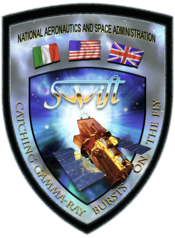
Back Swift Afrikaans مرصد سويفت الفضائي Arabic Misija Swift Gamma-Ray Burst BS Swift Gamma-Ray Burst Mission Catalan Swift Gamma-Ray Burst Mission Czech Swift Gamma-Ray Burst Mission Danish Swift (Satellit) German Swift (observatorio espacial) Spanish Swift (satelitea) Basque سوئیفت (ماهواره رصدگر) Persian
 Neil Gehrels Swift Observatory | |
| Names | Explorer-84 MIDEX-3 Swift Gamma Ray Burst Explorer |
|---|---|
| Mission type | Gamma-ray astronomy |
| Operator | NASA / Pennsylvania State University |
| COSPAR ID | 2004-047A |
| SATCAT no. | 28485 |
| Website | swift |
| Mission duration | 2 years (planned)[1] 20 years, 2 months, 6 days (in progress) |
| Spacecraft properties | |
| Spacecraft | Explorer LXXXIV |
| Spacecraft type | Swift Gamma Ray Burst Explorer |
| Bus | LEOStar-3 |
| Manufacturer | Spectrum Astro |
| Launch mass | 1,470 kg (3,240 lb) |
| Dry mass | 613 kg (1,351 lb) |
| Payload mass | 843 kg (1,858 lb) |
| Dimensions | 5.6 × 5.4 m (18 × 18 ft)[2] |
| Power | 1040 watts |
| Start of mission | |
| Launch date | 20 November 2004, 17:16:01 UTC |
| Rocket | Delta II 7320-10C (Delta 309) |
| Launch site | Cape Canaveral, SLC-17A |
| Contractor | Boeing Defense, Space & Security[3] |
| Entered service | 1 February 2005 |
| Orbital parameters | |
| Reference system | Geocentric orbit[4] |
| Regime | Low Earth orbit |
| Perigee altitude | 585 km (364 mi) |
| Apogee altitude | 604 km (375 mi) |
| Inclination | 20.60° |
| Period | 96.60 minutes |
| Instruments | |
| Burst Alert Telescope (BAT) UltraViolet Optical Telescope (UVOT) X-Ray Telescope (XRT) | |
 Swift Gamma Ray Burst Explorer Explorer program | |
Neil Gehrels Swift Observatory, previously called the Swift Gamma-Ray Burst Explorer, is a NASA three-telescope space observatory for studying gamma-ray bursts (GRBs) and monitoring the afterglow in X-ray, and UV/visible light at the location of a burst.[5] It was launched on 20 November 2004, aboard a Delta II launch vehicle.[4] Headed by principal investigator Neil Gehrels until his death in February 2017, the mission was developed in a joint partnership between Goddard Space Flight Center (GSFC) and an international consortium from the United States, United Kingdom, and Italy. The mission is operated by Pennsylvania State University as part of NASA's Medium Explorer program (MIDEX).
The burst detection rate is 100 per year, with a sensitivity ~3 times fainter than the BATSE detector aboard the Compton Gamma Ray Observatory. The Swift mission was launched with a nominal on-orbit lifetime of two years. Swift is a NASA MIDEX (medium-class Explorer) mission. It was the third to be launched, following IMAGE and WMAP.[5]
While originally designed for the study of gamma-ray bursts, Swift now functions as a general-purpose multi-wavelength observatory, particularly for the rapid followup and characterization of astrophysical transients of all types. As of 2020, Swift received 5.5 Target of Opportunity observing proposals per day, and observes ~70 targets per day, on average.[6]
- ^ "NASA Swift Mission Extended for 4 More Years". Omitron. Archived from the original on 8 April 2008. Retrieved 7 April 2008.
- ^ "Swift Facts and FAQ". Sonoma State University. 28 March 2008. Archived from the original on 24 June 2018. Retrieved 7 July 2015.
- ^ "Swift Explorer" (PDF). NASA. 1 November 2004. Retrieved 18 December 2016.
 This article incorporates text from this source, which is in the public domain.
This article incorporates text from this source, which is in the public domain.
- ^ a b Cite error: The named reference
Trajectorywas invoked but never defined (see the help page). - ^ a b "Display: SWIFT (Explorer 84) 2004-047A". NASA. 28 October 2021. Retrieved 4 December 2021.
 This article incorporates text from this source, which is in the public domain.
This article incorporates text from this source, which is in the public domain.
- ^ "Swift Mission Operations Center". PSU. 27 December 2021. Retrieved 27 December 2021.
 This article incorporates text from this source, which is in the public domain.
This article incorporates text from this source, which is in the public domain.